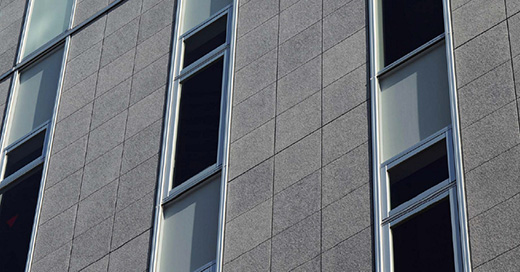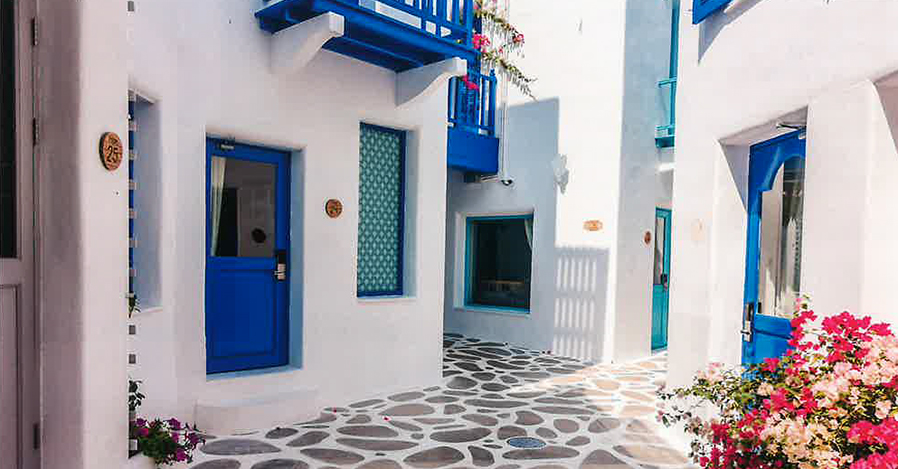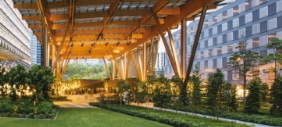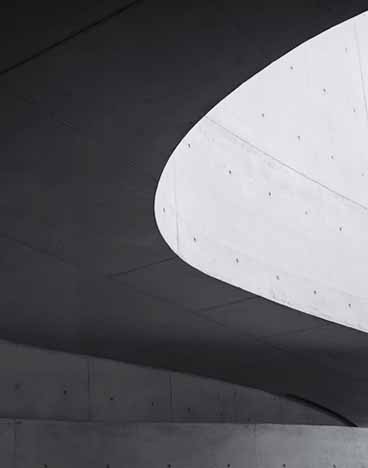2024.06.03 Architecture

Sustainable Architecture Around the World Part 4
Breath-taking beauty and unprecedented distinctive architecture have long been highly esteemed as "masterpieces". However, in recent years, buildings have come to be evaluated not only based on their design, but also on their sustainability.
According to the World Green Building Council in 2019, approximately 39% of the world's carbon emissions are related to the construction and building industry, with 28% being emitted through building operation such as air conditioning and electricity usage, and the remaining 11% being emitted through materials and construction.
To reduce such environmental burdens, various approaches to sustainable architecture have been undertaken, including the selection of building materials, construction methods, and effective utilization of energy and water resources. Furthermore, in addition to reducing environmental impact, sustainable architecture aims to solve issues such as providing habitat for living things and creating employment opportunities in economically disadvantaged areas, and strives to harmonize with the surrounding environment and solve problems.
Sustainable architecture is often evaluated based on the following three points.
Environmental Consideration
Sustainable architecture emphasizes minimizing the impact on the natural environment during the construction process and the use of buildings. Examples include the use of renewable energy, the implementation of energy-saving equipment, and waste recycling.
Social Aspects
Sustainable architecture gives priority to the health and comfort of residents or users. Considerations include residents' health, contribution to the local community, and the use of public spaces.
Economic Aspects
Sustainable architecture is required to be economically sustainable as well. Reduction of energy costs, efficient use of construction materials, and the development of long-term maintenance plans are important.
In the column, we will gradually introduce some famous examples of sustainable architecture from around the world.
31. Chapel of Sound Concert Hall
- Environmental
- Economic
“Chapel of Sound Concert Hall” is one of the world’s famous sustainable architectures, located in a rocky valley at the foot of Jinshanling Great Wall on Beijing’s northern border in China. The monolithic open-air concert hall by OPEN Architecture (https://www.openarch.com/task/387) was designed with minimal material consumption. The building was built entirely from concrete enriched with an aggregate of local mineral-rich rocks, and the wood strips of the formwork were all recycled. It encompassed a semi-outdoor amphitheatre, outdoor stage, viewing platforms, and a green room. Using no heating or air-conditioning, the “Chapel of Sound Concert Hall” consumes minimal energy, in keeping with this sustainable approach. The natural elements are allowed to come inside through the openings, allowing daylight to enter the structure through a void in the centre of the rooftop and naturally illuminating the performance spaces. Although the rainwater cascades through the void, the drainage system quickly drains the water away. The “Chapel of Sound Concert Hall” is internationally acclaimed as an outstanding sustainable architecture that achieves harmony between architecture and environment.
*Our product CERAMI CRETE Si was used for "Chapel of Sound Concert Hall ".
*Record of Awards
2023 China Design Excellence Awards by AIA Shanghai / Honor Award
2023 Créateurs Design Awards (France) / Best Commercial Project in Architecture
2023 Wallpaper* Design Awards / Best Public Building
2022 ArchDaily Building of the Year Award / Cultural Category Winner
2022 Fortune China Best Designs of 2022
2021 Wallpaper* Design Awards / Best Public Building
2021 Dezeen's Top 10 Chinese Architecture Projects of 2021
2019 P/A Awards (USA)

32. Carbon-Neutral Building
- Environmental
- Economic
“Carbon-Neutral Building” in Switzerland is a global pioneering example of sustainable architecture. This building has achieved carbon neutrality through design and technology that minimize environmental impact. Its features are diverse. Firstly, starting from the selection of materials used in construction, it maximizes the use of renewable resources and minimizes CO2 emissions. Additionally, high-performance insulation materials, windows, and energy-efficient equipment are used to reduce energy waste and achieve the use of sustainable energy. Moreover, renewable energy sources such as solar and wind power are actively introduced to supplement the building's energy needs. Furthermore, efforts such as waste recycling, water reuse, and greening are undertaken to reduce environmental burdens. With these features, “Carbon-Neutral Building” is widely acclaimed worldwide as a typical example of sustainable architecture.

33. Sydney Opera House
- Environmental
- Economic
“Sydney Opera House” is one of the world's famous sustainable architectures. This building demonstrates a thorough consideration for the environment from design to construction and operation. Firstly, its distinctive appearance resembling natural waves and sails of a sailing ship harmonizes with the surrounding landscape. During the construction, efforts were made to promote the use of renewable energy and minimize energy consumption. Solar panels have been installed on the roof to encourage the use of renewable energy. In addition, high-performance insulation materials and energy-saving equipment have been introduced to achieve efficient energy utilization. Furthermore, sustainable resource management, such as waste recycling and water reuse, is actively practiced. Inside the building, initiatives like maximizing natural light and ensuring airflow contribute to improving residents' comfort and quality of life. The “Sydney Opera House” is internationally acclaimed as an outstanding sustainable architecture that achieves harmony between architecture and the environment.

34. Land Architecture Inc.
- Environmental
- Economic
The “Land Architecture Inc.” in the United States is an exemplary case of sustainable architecture. The building has been designed to improve employee health and productivity while minimizing environmental impact. First, the building focuses on the use of renewable energy, with solar panels installed on the roof. In addition, high-performance insulation materials and energy-saving equipment are used to ensure efficient energy use. Inside the building, the design puts emphasis on the health and comfort of employees, including maximizing the use of natural light and planting greenery. Measures such as waste recycling and water reuse are actively implemented to reduce environmental burden. In addition, the building's design considers the local landscape and ecosystem, creating a harmonious architecture with the surrounding environment. The “Land Architecture Inc.” is widely praised in the industry as a prime example of sustainable architecture that balances environmental conservation with employee well-being.

35. Science Center
- Environmental
- Economic
Finland's "Science Center", especially Särkänniemi Science Park, is a typical example of sustainable architecture. Firstly, the building actively utilizes locally sourced natural materials and maximizes energy efficiency. Solar panels are installed on the roof, promoting the use of renewable energy. High-performance insulation materials and double-glazed windows protect the building from the cold in the winter and the heat in the summer. Waste recycling and water reuse are also emphasized to minimize environmental impact. Inside the building, eco-friendly technologies such as energy-saving equipment and LED lighting are implemented, optimizing energy consumption. Furthermore, maximizing natural light and indoor greenery contribute to a comfortable indoor environment. The “Science Center” is internationally recognized for its integration of sustainability and technological innovation, serving as a prime example of sustainable architecture.

36. Eastwood Apartments
- Environmental
- Economic
“Eastwood Apartments” in Australia are a typical example of sustainable architecture. This building is designed to minimize environmental impact while enhancing the comfort and quality of life for residents. Firstly, the building focuses on utilizing renewable energy, with solar panels installed on the roof. This enables self-sufficiency in electricity and reduces energy consumption. Additionally, high-performance insulation materials and double-glazed windows are used to improve the thermal insulation performance of living spaces. Furthermore, sustainable resource management practices such as waste recycling and water reuse are actively implemented. Inside the building, energy-saving equipment and LED lighting are installed to optimize energy consumption. Moreover, the design of the building puts a priority on the health and comfort of residents, including making use of natural light and ensuring proper ventilation. The “Eastwood Apartments” are internationally recognized as a typical example of sustainable architecture that provides a sustainable living environment.

37. Grand Designs Spain House
- Environmental
- Economic
“Grand Designs Spain House” in Spain is known as a masterpiece of sustainable architecture. This residence is designed to provide a comfortable living space while minimizing its environmental impact. Firstly, the building emphasizes the use of renewable energy, with solar panels installed on the roof. This enables the production of self-generated electricity, achieving energy self-sufficiency. In addition, high-performance insulation materials and well-ventilated structures are used to improve energy efficiency. Inside the building, energy-saving equipment and LED lighting are installed to optimize energy consumption. Furthermore, sustainable resource management practices such as waste recycling and water reuse are actively implemented. In terms of design, efforts are made to prioritize the health and quality of life of residents, including utilizing natural light and ensuring ventilation. “Grand Designs Spain House” is internationally recognized as an exemplary model of sustainable architecture that balances environment with quality of life.

38. The Edge
- Environmental
- Economic
“The Edge” in the Netherlands is considered a symbol of sustainable architecture. This building combines environmentally friendly design and technology, incorporating numerous innovative initiatives. “The Edge” is known as the world's first "energy-positive" office building, capable of generating its own energy needs throughout the year. The active use of solar panels and the adoption of high-performance insulation materials have contributed to this realization. Furthermore, within the building, energy-efficient LED lighting and energy-saving facilities are installed to minimize energy consumption. Active measures such as waste recycling and water reuse are also implemented to reduce environmental impact. Additionally, the building utilizes smart technology to enhance employee productivity and comfort. “The Edge” is acclaimed worldwide as a masterpiece of architecture that embodies the fusion of sustainability and technology.

39. San Francisco Federal Building
- Environmental
- Economic
The “San Francisco Federal Building” in the United States is renowned as a masterpiece of sustainable architecture. This building is characterized by its environmental consciousness and energy efficiency. Firstly, the building maximizes the use of renewable energy, with solar panels installed on the roof. This enables the production of self-generated electricity, achieving energy self-sufficiency. Additionally, high-performance insulation materials and double-glazed windows are used, enhancing the thermal insulation performance of the living spaces. Inside the building, energy-efficient equipment and LED lighting are installed, optimizing energy consumption. Furthermore, active measures such as waste recycling and water reuse are implemented for sustainable resource management. The building's design also focuses on the health and quality of life of its residents, including making use of natural light and ensuring ventilation. The “San Francisco Federal Building” is internationally acclaimed as a prime example of sustainable architecture with thorough consideration for energy efficiency and environmental impact.

Column categories
Access Ranking
Portal categories
Access Ranking

Functional
2024.02.28
Fair-Faced Concrete and Sustainability - Open up New Possibilities of Fair-Faced Concrete -

Material
2023.01.20
What are the advantages of expressing with a textured product instead of using natural stone?

Functional
2023.12.01
Relationship Between Paints and Sustainability

Functional
2024.01.29
Functionality and Sustainability 1 -Stop Dirt & Stains on Exterior Wall! -

Material
2024.04.03
Rich Colours and Designs Are the Key! -Sustainable Design-

Architecture
2024.04.03



